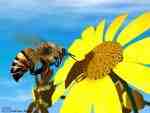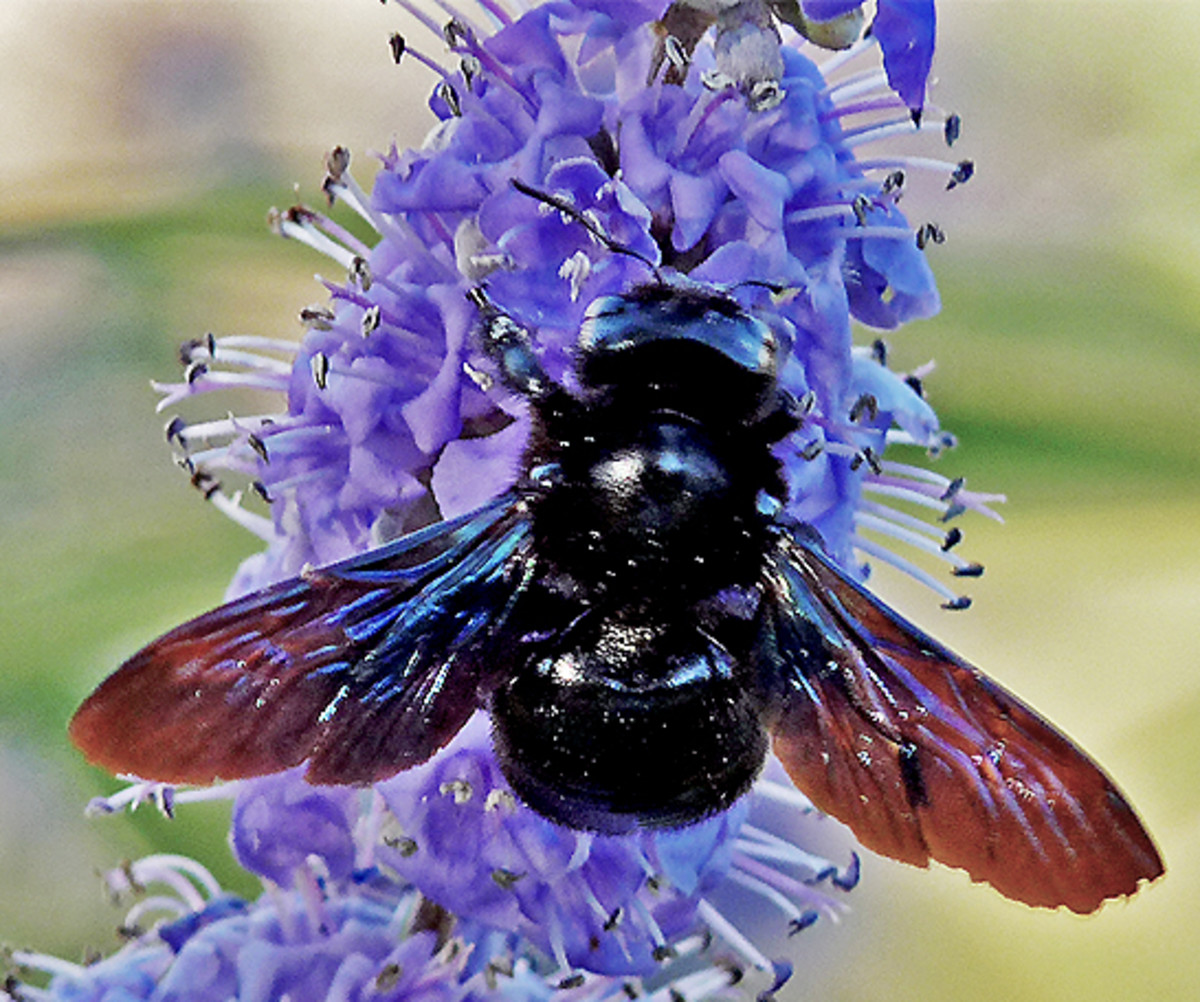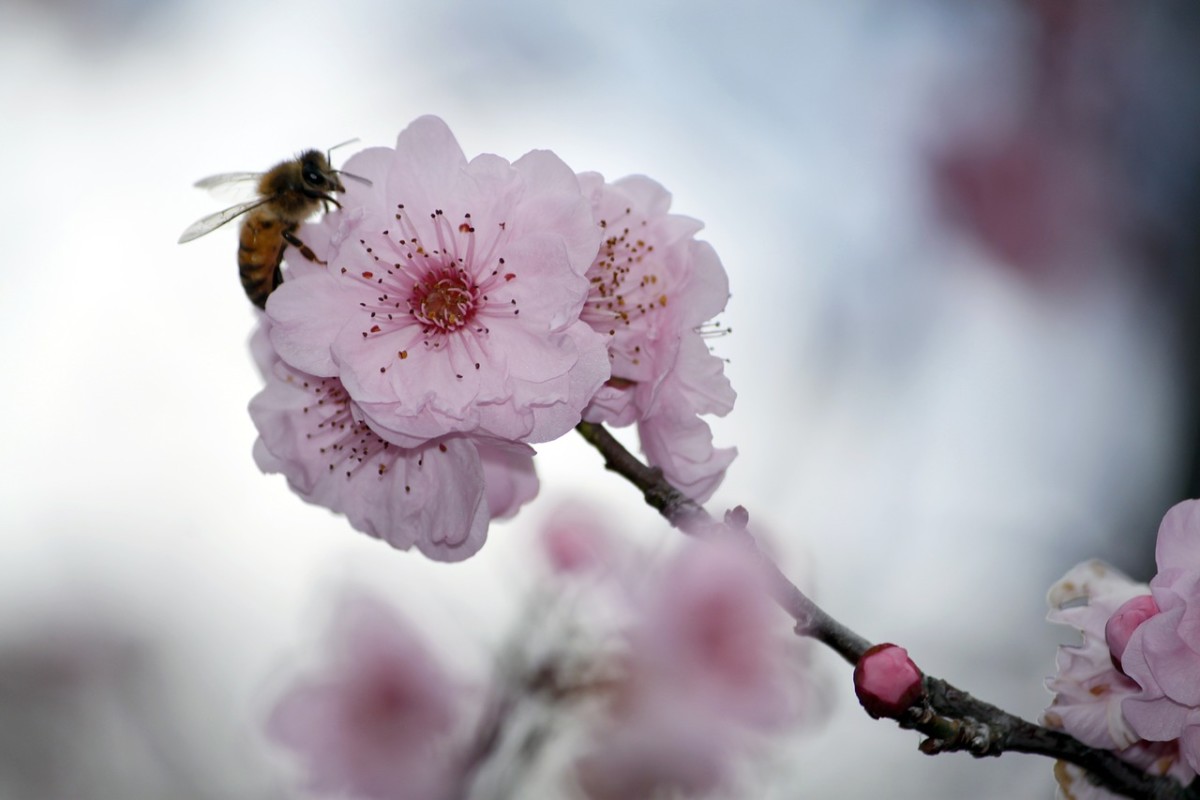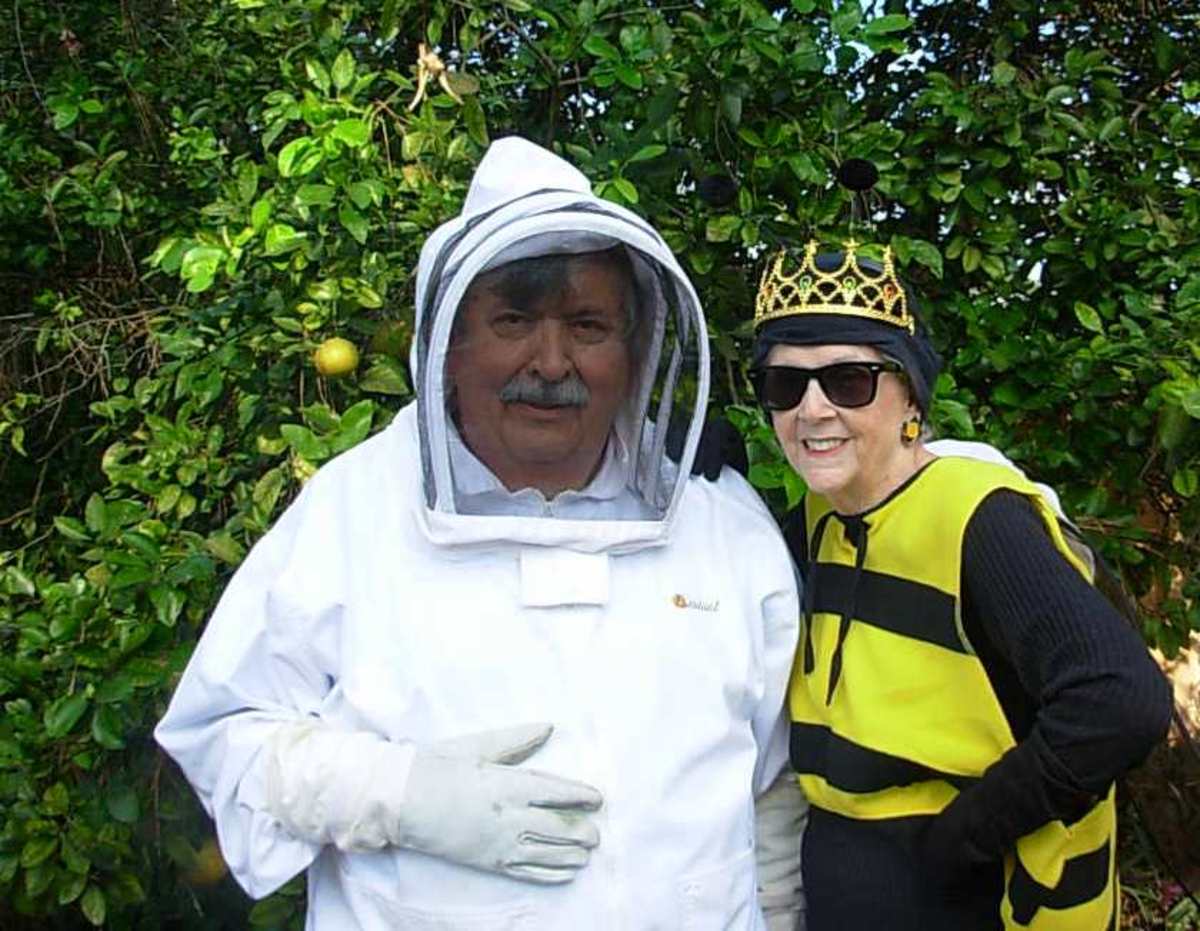Bees: Hives, Honey and Stings!
The slumberous sound of the honeybee means summer is here.

Added chapter on honey follows and Notes on Bee Stings
.
A tiny word that can be made even more humble by replacing it with the second letter of the alphabet, “B,” hardly compliments one of the most fascinating creatures in our world.
In general, mankind loves the best known of the bee family, the honeybee. Unless we disturb its hive or nest it is rarely aggressive towards man, not at all like the wasp, a predatory creature which often seems to attack us, as the old joke goes, “just for the halibut.”
Strange how the bee and wasp temperament differs, after all, the come from the same family, the Hymenoptera, which also includes the ants and sawflies. All of this family, even the belligerent members, are important and vital pollinators. Wasps, despite all their bad press, also rid of us of many other insects which menace our crops, as do ants as well.
When we take on a study of the bee, we will examine a family with more than 20,000 known species world-wide, and perhaps as many again we have not yet documented. They are nearly everywhere, excluding only high mountain tops, a few isolated oceanic islands and the polar regions. But mamma bee didn’t raise no fools, they prefer the warmer parts of the globe. Most of our bees that we keep for honey production are quite soberly dressed in dark colors, but bees are found in a multitude of colors, including some with a metallic sheen.
Unlike aviation, the bee has so far stuck to a biplane configuration, having four wings and the family characteristic shape of a narrow waist separating thorax (throat and head) from the abdomen. Apart from carrying the sting, the ovipositor can also pierce, saw and lay eggs. Bees are cautious about stinging you because they know once the sting is ripped out, they cannot live. Unlike chickens, bee eggs still hatch if unfertile, but the result is always male; fertilized eggs become females.
There are eleven families of bees, from the most simple, the wasp-like cellophane bee, to the complex societies of honey bees. These are the mining bee, leafcutter and masonry bees, sweat bees and digger and carpenter bees (please see my hub article on the carpenter bee). Many bees are solitary or live in small, close knit communities.
It is the honey bee which lives in the large communities, part of a complex society of workers, drones, queens and soldiers; they also, along with stingless bees, hoard large quantities of honey, a fact exploited by man and certain other animals, such as bears, for thousands of years.
Many insects transfer pollen from plant to plant, but none as splendiferously as the bee. This cross pollination is the benchmark symbiotic relationship of the natural world. One of the pleasures of a summer’s day in the garden or country is a multitude of bees murmuring drowsily as they move from flower to flower, harvesting nectar and collecting pollen to feed their larvae, and happily sprinkling a little of their precious cargo on the reproductive pistils of other plants. So each precious mite journeys on, meeting the needs of plant seed fertilization; gently vying with the butterflies as they inspect each bloom. If only man’s frenzied commercial endeavors could be this laid-back and full of charm, and our cities so well planned and efficient as the bee hive.
Tragically, for many useful and beautiful creatures such as bees and butterflies, they spend the greater part of their lives in the egg/larvae/pupae stages before they attain adulthood and the glory of flight, mating and socially interacting with their own kind.
The social bees, known as apinae, contain honey bees and bumble bees. Bumbles do live in nests with other females of their immediate family. Males play no part in the nest building or caring for eggs and larvae, being confined to only mating with the queen…kind of Prince Philip of the bee world.
Like ants, a colony of honey bees seem to function as a single organism. With bees, this showcases the power of collected thought when you consider a community may include as many as 100,000 members! Each colony has but one queen, who is kept very busy as a kind of egg production machine; the rest are made up mainly from immature females and drones (male) bees. Only the females are equipped with stings. There is about a ten to one ratio in favor of the females, so it’s safe to assume the bee little Johnny is just popping in his mouth will shortly have you in the nearest hospital emergency room. Bee stings in the throat or mouth can be fatal even for those who are not allergic to as the swelling closes breathing passages.
Bee nutrition depends on several substances such as nectar which is converted into honey. Believe me, the bees really hate you taking their carefully hoarded honey. I was a bit misty eyed recently in a bee keeper’s farm in Spain when I saw the poor bees carefully cleaning every drop of their stolen honey from that left sticking to the inside of the vessels and centrifuge where it had been purloined from the combs. Jesus’ exhortation, “forgive them, they know not what they do,” seems appropriate when applied to those who regularly steal the yearly honey production, whether in the wild or in commercial hives. (I’m just as guilty, I love honey). Nectar contains a high percentage of water when collected, but most is removed during honey production, leaving the honey with only about 20% or less water.
Bees also collect a little known substance from other insects known as honeydew; this is used like honey. The pollen collected by the bees represents the protein the young bees will need; another little known substance, propilis, is collected from the buds of trees - it is used as a resinous glue for repairing the hive or for mummifying objects such as marauding insects the bees don’t want in the hive with them. Quantities of water are also imported to cool the colony and dilute some of the honey before consumption.
Man began providing hives for bees as long as 2000 years ago. Bees use waxy deposits underneath their bodies to construct the marvelous combs lined with back-to-back hexagon cells. These are used for storage and to rear the young from eggs laid by the queen. The bees like a high temperature in the hive of around 93F (34C) which they will maintain despite outside temperatures falling to less than 50F. This is why there are no bees in polar latitudes; any weather colder than this will have the whole hive huddling around the eggs and larvae to preserve the heat, where they can survive weeks on end.
The marvel of preparing the colony to expand begins as the warm months arrive and the hive is overcrowded. Worker bees have chosen some 10 or more larvae which would have become workers, to become crowned into new virgin queens. They do this by feeding them a special substance manufactured in the thorax called royal jelly. The first queen to emerge from the larval stage kills all the others!
Just before this unhappy event (nature can seem cruel, can’t it?) the old queen and about half of her subjects, called a swarm, take off to find a suitable place to form a new colony and the successful young virgin takes over as queen of the old hive. This buzzing cyclone of swirling bees usually alights somewhere - anywhere - so workers can form a tight guard around the mother queen while selected workers scour the surrounding countryside for a new home.
Back in the old hive, the new queen - about three times the size of the other bees - takes several flights around the old place before she settles inside to perform her arduous duty of mating and giving birth. She won’t leave this job again until it’s time for her to copy her long-gone mother and take thousands of her children off to find her own new home.
Bees have a marvelous way of communicating by means of a “dance.” When returning to the hive loaded with pollen and nectar a bee will perform a series of dance movements for the other bees that indicate direction, distance, type of food and other commands. The audience will then take off and proceed according to the directions. Her directions are so numerous, precise and accurate, the number and complexity is beyond this article, but information can be found in one of the many books on the honey bee and, I expect, online. It is nothing short of a marvel of evolution and shows how instinct can become complex in all creatures, explaining how man came to perform his myriad functions
Honey. Honey is one of the oldest edible substances known to man and has been around the human scene for something like 8,000 years. Nomadic tribes in many cultures availed themselves of honey, as did many wild animals and insects. No wonder the poor bees attempt to guard their valuable product so assiduously, if not very successfully in the face of man’s cunning.
People, like the ancient Egyptians and the Chinese have been keeping bees for more than 2,000 years. Honey has been used as a food, a sweetener, as part of medicinal herbal concoctions - both consumed and applied, and a huge part of sacrifices. It is mentioned in the Doomsday Book, among other ancient writings, as having been used for the payment of dues. At many times, it was the province of the wealthy and the parvenu were not allowed to have it. (Although it was fed to sacred animals…in one case, even to a crocodile considered a minor deity!). Both Hippocrates and Aristotle touted honey’s medicinal properties (most of which we think of as bunkum today).
In a rare gesture of generosity (they mainly raped and pillaged) the Spanish first took the European honeybee to the Americas. They found that bee keeping and honey harvesting, using the tiny, stingless bees, had been going on for centuries already. The honey produced by these “angelitos,” or little angels, was thinner than that of the European bee, but preferred by the Aztecs, Mayans and other tribes.
Honey remained unknown to North America for about another 100 years when settlers from Britain and Europe arrived with their “white man’s flies,” as the Indians called the bees. Apiculture soon caught on for a variety of uses and remains big business today, although honeybees have been decimated at an alarming rate over the last 5 years or so: no one is quite sure why.
Bees have come up against special interests in several areas of the Tropics , such as Cuba, where sugar plantation owners have accused beekeepers of allowing their charges to stealing the sugar cane. A preposterous idea if thought about logically and with any scientific knowledge of the habits of the bees.
Probably the ancients Greeks first brewed Mead. They seem to have coined the word for the sweet, fermented libation: in fact, the word for honey is close to that for mead in many languages, (In Spanish it is "miel"). It would seem to have had the importance the sap from succulents, pulque, did to the early Mexican tribes. Replaced by ales, mead seems generally lost to modern man, which seems a great shame, as mead has played such a huge part of the social scene in so many lands over the last perhaps 200 or more years. I expect the recipe is on Google!
As regards sweeteners, honey has no equal - although nutritionists today tell us it is only marginally better for us than sugar in our drinks. My own favorite way to take honey - I love the stuff - is mixed into Greek style yoghurt mmmmm! Or spread thickly on a fresh-baked granary slice on top of a thick layer of butter…my arteries!…I don’t care!
Apiculture would seem the most symbiotic and gentle agribusiness of any involving a living creature. We do take their honey, but modern hives are designed so they bees have been shunted to the bottom of the comb frames before the honeycombs are removed. No doubt this is a time of huge anxiety for the little girls - mainly. But professional beekeepers don’t take quite all the honey production: there is usually an excess made anyway and the hive soon gets to work making a lot more.
It’s a wonder, though, they haven’t all become killer bees after the millenniums of robbery. Perhaps all these nice, weatherproof hives we supply balances out the transaction.
The word “honey” has become common coinage in many languages. The Spanish speakers say “miel,” but use the word almost as we do. In American English mainly (but catching on in UK) it has been the most popular endearments for… How long, Gringos? 100 years? I guess it’s because we love and estimate the stuff so much.
“It’s money, honey, my little sonny,
And the rich man’s joke is always funny!”
Notes. Bee stings.
Most bees can sting. Honeybees generally only do so when their hive is attacked or they are accidentally injured by being stepped on, etc. At the same time as the barbed stinger goes in, the bee releases pheromones as a kind of SOS to other bees which may arrive quickly to aid their fallen comrade. This substance does not wash off easily in water, as those jumping in a stream to avoid bees have found. When they come up for air, the annoyed bees quickly return. The queen bee has a different, smooth stinger, used mainly to dispose of rival queens and she is capable of multiple stings. In fact, all bees are if their stings are used as they were intended, to defend the hive against other bees. Only when they sting into the elastic skin of a human, other mammal or a bird does the stinger get caught, pulling out of the bee and causing death of the bee within a short time. Some people have said that keeping still allows the bee to withdraw its sting. I doubt this is often true and it would take superhuman willpower; most people are too busy hopping about and trying to get the stinger out to worry about the fate of the bee.
The stinger should be removed as soon as possible, as it can continue to pump in venom even after being separated from the bee. Melittin and histamine charged bee stings may not be quite as painful as that of the wasp and hornets, but its effects can last longer with itching and soreness for up to a week. Doctors say these is a slight chance of tetanus, which would be the worst one could expect, along with the unfortunates who receive multiple stings, or are allergic to bee stings and may have an anaphylactic shock. Once a war party of bees does get upset with you, they can be very nasty and aggressive indeed, only ceasing when you have been stung to death or have swiftly departed the area, which you must do, as any aggression on your part will only make the situation much worse with thousands more bees joining the ranks.
.



